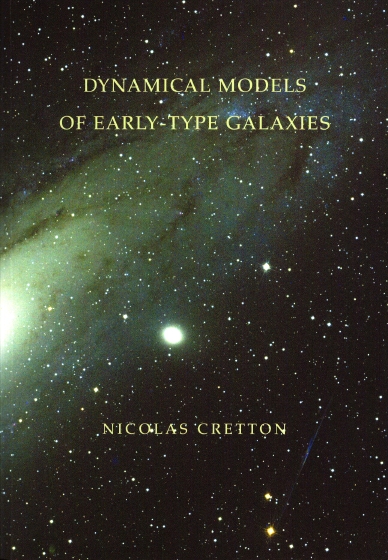
|
|

Ricerca personalizzata
|
|
|
La mia laurea di dottorato (PhD thesis):
Dynamical models of early-type galaxies

Scarica il file pdf cui (6.2 MB)
Scarica le proposizioni ("Stellingen") che accompagnano questa laurea qui.
Tavola delle materie
1. Introduction1.1 Understanding galaxies: structure, formation and subsequent evolution
1.2 Massive Central Black Holes
1.2.1 How to detect Black Holes ?
1.2.2 The problems with the data
1.2.3 The problems with the models
1.3 Dark Halos
1.4 Aim of this thesis
1.5 Galaxy Dynamics
1.5.1 Prelude
1.5.2 Velocity Profiles
1.5.3 The tools of the galactic dynamicist
1.5.4 Schwarzschild models: a historical perspective
1.5.5 Improvements of the Schwarzschild method
1.6 Outline and Summary
1.6.1 The dark halo of NGC 2434
1.6.2 Axisymmetric three-integral dynamical models
1.6.3 Black holes in M32 and NGC 4342
1.6.4 The internal dynamics of NGC 2320
2.1 Modeling technique
2.1.1 Orbit Library
2.1.2 Observables
2.1.3 Comparison with the observational constraints
2.1.4 Regularization
2.2 An illustration of the method
2.3 Improved mass modeling for elliptical galaxies
2.3.1 Choice of potentials
2.3.2 An application: The dark matter halo around NGC 2434
2.4 Conclusions
2.A The differential mass density
2.A.1 Inferring the distribution function from the orbital weights
2.A.2 Construction of f(E)-components
2.B Cosmologically motivated star+halo models
3.1 Construction of Dynamical Models
3.1.1 Mass Model
3.1.2 Choice of Orbits
3.1.3 Orbit Calculation
3.1.4 Storing the Orbital Properties
3.1.5 Modeling Observed Kinematical Quantities
3.1.6 Fitting the Constraints
3.1.7 Regularization
3.2 Two-integral Components and Isotropic Components
3.2.1 Definition
3.2.2 Velocity Profiles
3.3 Tests
3.3.1 The Test Model
3.3.2 Reproducing the Test Model with Two-integral Components
3.3.3 Reproducing the Test Model with Regular orbits
3.4 Concluding Remarks
3.A Construction of f(E,Lz)- and f(E)-components
3.A.1 Normalization
3.A.2 Velocity profiles
3.B Relation Between Orbital Weights and the DF
3.B.1 dM/dEdLz for an f(E,Lz) model
3.B.2 Scale-free Density in a Kepler Potential
4.1 Mass density and potential
4.2 Construction of two-integral models
4.3 Predictions of two-integral models
4.3.1 Data-model comparison
4.3.2 Is the M32 distribution function of the form f(E,Lz)?
4.4 Construction of three-integral models
4.5 Predictions of three-integral models
4.5.1 Implementation
4.5.2 Data-model comparison
4.5.3 Smooth solutions
4.5.4 Dynamical Structure
4.6 Models with an extended dark nuclear object
4.7 Conclusions and discussion
4.7.1 Summary of results
4.7.2 Dynamical stability
4.7.3 Dynamical relaxation
4.7.4 Triaxiality
4.7.5 Adiabatic black hole growth
4.7.6 Tidal disruption of stars
4.7.7 Accretion onto the black hole
4.7.8 Forthcoming observations
4.A χ2-topology for orbit-superposition models
5.1 The data
5.1.1 Photometric data
5.1.2 Kinematic data
5.2 The mass model
5.3 Jeans modeling
5.3.1 Formalism
5.3.2 Application to NGC 4342
5.4 Three-integral modeling
5.4.1 The method
5.4.2 The orbit library
5.4.3 The observational constraints
5.4.4 Non-negative least squares fitting
5.4.5 Regularization
5.5 Shortcoming of the Gauss-Hermite parameterization
5.6 Results and discussion
5.6.1 The black hole and mass-to-light ratio
5.6.2 Alternatives to a black hole
5.6.3 The dynamical structure of NGC 4342
5.6.4 The influence of central radial anisotropy
5.6.5 The density distribution in the outer region of NGC 4342
5.6.6 Comparison with other BH detections
5.7 Conclusions
6.1 The data
6.1.1 Photometric data
6.1.2 Stellar kinematic data
6.1.3 Kinematics of the ionized gas
6.2 The models
6.2.1 The mass model
6.2.2 The dynamical models
6.3 Results
6.3.1 Fits to the data
6.3.2 Goodness of fit
6.3.3 Intrinsic velocity dispersions
6.4 Conclusions and Discussion
Nederlandse Samenvatting
English Summary
Curriculum Vitae
Acknowledgments